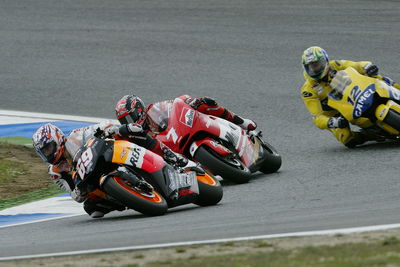Slicks in wet scary, but flag-to-flag passes test.
The first test of the new MotoGP 'flag-to-flag' racing rule, which means dry races will no longer be stopped due to rain and riders instead have the chance to change bikes, passed without major problem at Estoril on Sunday - although nobody enjoyed riding on slick tyres in the rain.
The weather conditions, which saw the rain never much more than a gentle drizzle, were in effect the worst case scenario - since the conditions weren't wet enough to justify a bike swap.

The first test of the new MotoGP 'flag-to-flag' racing rule, which means dry races will no longer be stopped due to rain and riders instead have the chance to change bikes, passed without major problem at Estoril on Sunday - although nobody enjoyed riding on slick tyres in the rain.
The weather conditions, which saw the rain never much more than a gentle drizzle, were in effect the worst case scenario - since the conditions weren't wet enough to justify a bike swap.
That was because, even if the significant issue of a 50-second time loss for pitting is put to one side, a bike on wet weather or even intermediate tyres wouldn't have been as quick as a bike on slicks in those part wet conditions.
"They put out the white flag, but I didn't think about coming in for one moment, it wasn't raining enough for that, and it wasn't even worth putting on intermediate tyres," confirmed race winner Alex Barros.
So all riders stayed out and, with the exception of Sete Gibernau and John Hopkins, were able to bring their machines to the chequered flag (although the likes of Colin Edwards and Troy Bayliss also fell, but were able to rejoin).
The reality is that even if the race had been stopped, it would have been restarted with almost all riders still on slicks, for the performance reasons stated, making the stoppage useless in terms of rider safety.
In short, new rules or old, the riders would have been riding on slicks in the rain on Sunday. But that doesn't mean they had to like it...
"The most difficult thing was to see the flags signalling rain when I was on slicks at 300kmph. That was really scary!" said Ducati's Carlos Checa after finishing fifth.
"It is very difficult to ride a MotoGP bike on slick tyres on a wet track," confirmed Kawasaki Shinya Nakano, while former world champion Kenny Roberts used stronger language: "It was pretty dangerous out there and we just never knew what the weather was doing."
"It was a horrible feeling to ride with slicks in the wet," added world champion Valentino Rossi. "I gradually got used to the conditions during the race but it's not ideal to ride like that.
"The new wet race rules are better for TV but it's not entirely safe, although it's clearer now for all the riders when the race has been declared as wet," he continued. "I think it's impossible in our sport though to find a perfect rule for that."
Ducati MotoGP project manager Livio Suppo agreed with his fellow Italian: "So finally we saw how the new flag-to-flag rules were in a race. That was a typical situation in which it was difficult to make a decision, as it was tough to see how hard the rain was coming but in the end it all worked out. If they had stopped the race I think it would not have been any different."
The only question now is what exactly will it take to force riders to pit? Basic maths regarding the time lost in pit lane (around 50-60 seconds) and the length of a MotoGP race (around 45-50 minutes) means that in order to make up for the time lost, heavy rain needs to fall in the first half of a race - and it would need to be of monsoon proportions to make riders pit in the closing stages.
Anything less and the riders will be wobbling around on slicks - but will that be any more dangerous than hitting an unexpected damp patch, at full (dry) racing speeds, as seen on Sunday?
"The track conditions were really unbelievable. Some places it was wet, other places dry and no one stopped in the pits, because it would have been pointless," said Loris Capirossi. "Luckily only a few riders fell and none fell down in the last three or four laps, when it began raining even more heavily."
The final question is whether the white flags are really necessary? Why not just let riders pit for a bike change - given that they must leave the pits with a different type of tyre - as and when they want?












